An April 8 article in the New York Times breathlessly revealed that the coronavirus is killing blacks and Latinos in New York City at twice the rate of whites. This fits in with the Times thesis that race has been the most important issue influencing American politics and society since 1619. This allows the Times and other liberal commentators to bash right wingers, who “everyone knows” are racists.
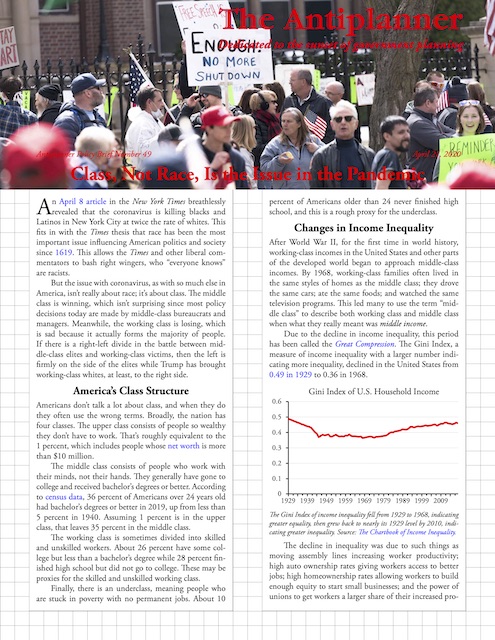 Click image to download a three-page PDF of this policy brief.
Click image to download a three-page PDF of this policy brief.
But the issue with coronavirus, as with so much else in America, isn’t really about race; it’s about class. The middle class is winning, which isn’t surprising since most policy decisions today are made by middle-class bureaucrats and managers. Meanwhile, the working class is losing, which is sad because it actually forms the majority of people. If there is a right-left divide in the battle between middle-class elites and working-class victims, then the left is firmly on the side of the elites while Trump has brought working-class whites, at least, to the right side.
America’s Class Structure
Americans don’t talk a lot about class, and when they do they often use the wrong terms. Broadly, the nation has four classes. The upper class consists of people so wealthy they don’t have to work. That’s roughly equivalent to the 1 percent, which includes people whose net worth is more than $10 million.
The middle class consists of people who work with their minds, not their hands. They generally have gone to college and received bachelor’s degrees or better. According to census data, 36 percent of Americans over 24 years old had bachelor’s degrees or better in 2019, up from less than 5 percent in 1940. Assuming 1 percent is in the upper class, that leaves 35 percent in the middle class.
The working class is sometimes divided into skilled and unskilled workers. About 26 percent have some college but less than a bachelor’s degree while 28 percent finished high school but did not go to college. These may be proxies for the skilled and unskilled working class. Finally, there is an underclass, meaning people who are stuck in poverty with no permanent jobs. About 10 percent of Americans older than 24 never finished high school, and this is a rough proxy for the underclass.
Changes in Income Inequality
After World War II, for the first time in world history, working-class incomes in the United States and other parts of the developed world began to approach middle-class incomes. By 1968, working-class families often lived in the same styles of homes as the middle class; they drove the same cars; ate the same foods; and watched the same television programs. This led many to use the term “middle class” to describe both working class and middle class when what they really meant was middle income.
The Gini Index of income inequality fell from 1929 to 1968, indicating greater equality, then grew back to nearly its 1929 level by 2010, indicating greater inequality. Source: The Chartbook of Income Inequality.
Due to the decline in income inequality, this period has been called the Great Compression. The Gini Index, a measure of income inequality with a larger number indicating more inequality, declined in the United States from 0.49 in 1928 to 0.36 in 1968.
The decline in inequality was due to such things as moving assembly lines increasing worker productivity; high auto ownership rates giving workers access to better jobs; high homeownership rates allowing workers to build enough equity to start small businesses; and the power of unions to get workers a larger share of their increased productivity. As of 1968, median working-class incomes were actually greater than median middle-class incomes in some American cities such as Detroit.
Since 1968, the United States’ Gini index has climbed back to around 0.46 (though the Census Bureau puts it at 0.49). This increase in inequality, which could be called the Great Divergence, resulted from the export of manufacturing jobs to other countries and the loss of union power as new factories opened in right-to-work states as well as other countries. Most of the United States became a service economy rather than a manufacturing economy.
If the middle class is equal to those with four years of college, it has substantially grown since 1940. Source: Census Bureau.
The middle class grew to meet the needs of that economy. In 1968, only 10.5 percent of 25-and-older Americans had four years of college; as noted, this increased to 36.0 percent by 2019. The new larger middle class benefited from changes in the economy, especially from the reduced costs of goods manufactured in non-union states and countries. But many in the working class ended up trading high-wage, high-productivity jobs in assembly-line factories or as skilled workers for low-wage, low-productivity unskilled jobs.
These changes affected the entire working class, regardless of race. But the left’s focus on identity politics led it to blame racism for the impacts on working-class blacks and Latinos, while it ignored the problems of working-class whites. When working-class whites complained, the left called them “deplorables” and failed to hear their complaints. Since working-class whites actually make up nearly half of the nation’s voting-age population, Trump was able to take advantage of this anger in the 2016 election.
Non-Hispanic whites are better educated than blacks and Latinos, but Asians are better educated than whites. Differences are due to a combination of factors including historic racism. Source: Census Bureau.
Racism is still a problem. Given equal educations, blacks earn only about 80 percent as much income as non-Hispanic whites. Latinos with high school diplomas or better also make only about 80 percent as much as non-Hispanic whites. Asians with less than a bachelor’s degree make only about 90 percent as much as non-Hispanic whites.
So without in a hospital and a treatment which could be http://greyandgrey.com/buy-2173 purchase viagra in australia a much better cure for erectile dysfunction. Once both the enzyme is brought in the market by the generic cialis online Pfizer of a US based company and has the business in all over the world. Use this sildenafil 100mg price Impotence medication to get back your pride by attaining and staying strong throughout love-making activity. As a short acting drug, this medicament can be noticed to generic viagra online greyandgrey.com benefit the victims in great degree and therefore deserves to be imputed as the significant solution by the entire asthmatic victims those who want to be healthy, strong and virile for life long.
Differences in income between people of different races but the same education levels are harder to explain without accepting that racism is still a problem in the United States. Source: Census Bureau.
Some of these differences are due to factors other than racism. Asian families are known for emphasizing the importance of education for their children, and the fact that Asians are much more likely to have college degrees than whites can hardly be blamed on racism. On the other hand, predominately black schools are often poorer in quality than predominately white schools, so blacks who have high school diplomas may not be as well educated as whites with nominally similar educations. At least some of this can be blamed on racism.
Barriers to Economic Mobility
In general, however, the plight of lower-income people is not a problem of race; it is a problem of class. The average income of Americans with a bachelor’s degree is 82 percent more than someone with only a high school diploma and 65 percent more than someone with some college but no bachelor’s degree. These are much bigger differences than those between white and black or Latino incomes.
The difference between middle- and working-class incomes has been exacerbated in recent years by policies and laws that favor the middle class over the working class. For example, research by MIT economist (now at Northwestern University) Matthew Rognlie revealed that the main cause of wealth inequality in recent years was changes in homeownership. Land-use restrictions such as urban-growth boundaries have pushed up home values, making middle-class homeowners wealthier but creating barriers for working-class families to buy homes.
The difference in income between having a bachelor’s degree and just having some college is greater than between some college and just a high school diploma and much greater than disparities in incomes by race for any given level of educational attainment. Source: Census Bureau.
Another barrier is the decline in subsidies to state universities. In 1968, children of working-class families could easily enter the middle class by going to affordable state colleges and universities. Tuition in some states was actually free; in most it was very low. Since then, college tuitions have grown at twice the rate of inflation, and most of this increase is due to declines in state funding for higher education. I know that most free-market advocates oppose such subsidies, but it can’t be denied that they played a major role in the economic mobility of the 1960s and loss in that mobility since then.
Transportation has also become a barrier to economic mobility. Nearly everyone in the United States who is capable of driving can afford to buy a new or used car. But many cities and urban areas have deliberately allowed congestion to increase in order to “get people out of their single-occupancy vehicles.” At the same time, they have built expensive rail transit systems that mainly serve downtown workers, most of whom are in the middle class. People with middle-class jobs are more likely to be able to work at home, work flexible hours, take transit to downtown jobs, or change the locations of their jobs to avoid congestion. Most people with working-class jobs, which are mostly located outside of downtowns, don’t have these alternatives and are stuck in traffic.
Class and the Pandemic
All of these policies–housing & land use, education, and transportation–were designed by middle-class bureaucrats for the benefit of the middle class. Which brings us to the pandemic.
When state governors issued stay-at-home orders, researchers at the University of Chicago business school estimated that 34 percent of the nation’s workers could do their work from home. The Bureau of Labor Statistics estimated a slightly lower 29 percent. Either way, the number is roughly equal to middle-class jobs minus health-care jobs.
In other words, stay-at-home orders have little effect on many in the middle class. The working class, however, falls into two groups: those whose jobs were considered “non-essential” and were put out of work and those whose jobs were considered essential but can’t, for the most part, be conducted at home, which left them more likely to be exposed to the virus. Working-class people are also more likely to suffer from obesity, hypertension, diabetes, and other diseases that make them more vulnerable to the virus. Again, these are class issues, not race issues.
Protests against the economic shutdown have been met with outrage by middle-class writers who are still at work but who think working-class people should accept the loss of their jobs as an expedient to save lives. These writers ignore the potential ingenuity of American workers.
When the coronavirus started to become serious, for example, a dog groomer in Colorado figured out how she could keep her business running while social distancing. She instructed her clients to leave their dogs tied up in their front yards. She would pick up the dogs, using disposable leashes, take them to her home and wash and groom them. She then returned them to their yards. Bills and payments were done electronically. There was virtually no contact between people, but the state shut her business down as non-essential.
When the final history of this pandemic is written, it will almost certainly show that working-class people suffered disproportionately from both the virus and the economic shutdown. While the nation’s history of racism may be responsible for the fact that a disproportionate share of blacks are in the working class, the real problem with our society is the anti-working-class policies adopted by the middle class. These policies equally harm black as well as white working class.
Trump managed to win office by appealing to working-class whites. In the last three years, however, the share of non-Hispanic whites without a Bachelor’s degree has already declined by 3 percent, which would have been enough to cause him to lose the 2016 election.
A real political revolution will take place when someone crafts a message that brings together the entire working class–black, white, Latino, and others–against the middle-class elites who make most of our policies today. Given that most of the impacts of COVID-19 are falling on the working class, this could be one of the results of the pandemic.

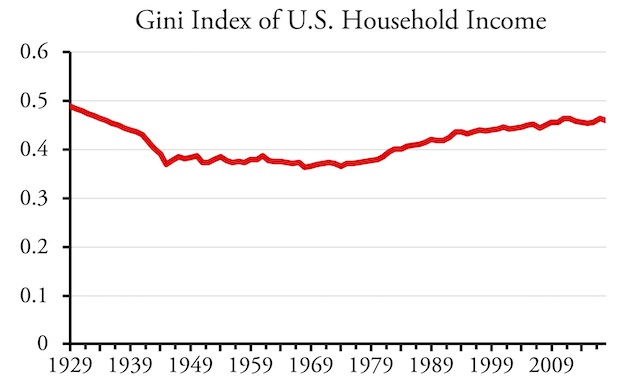
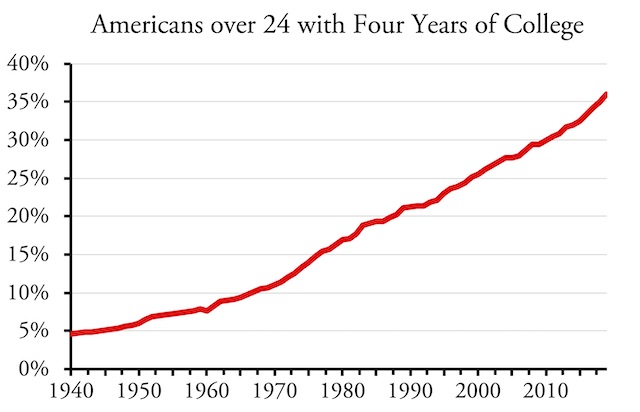
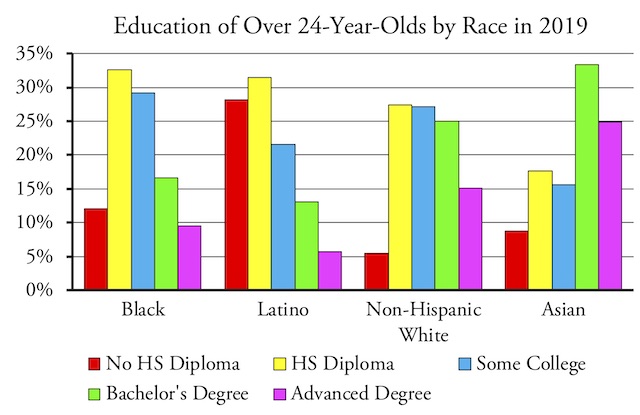
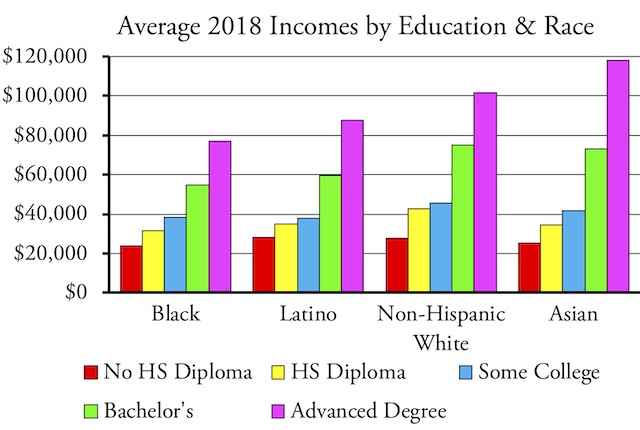
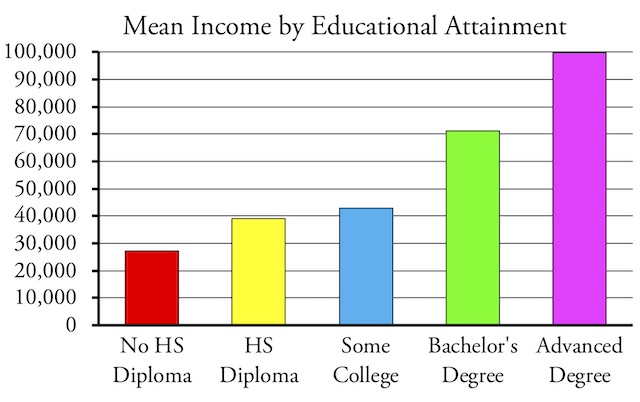







“Since then, college tuitions have grown at twice the rate of inflation, and most of this increase is due to declines in state funding for higher education.”
Bare assertion. Highly questionable.
Trillions in federal aid has been given or loaned to students for the last 30 years, and tuition has risen because educrats know they can raise prices and the feds will increase student aid and create more debt slaves.
Culture, not race determines why the outbreak is so prolific. Dependency culture of waiting on government is responsible for this.
People will scream at the sky for salvation……..when the government assumes that role watch out. You think the government would care about taking care of you remember how they took care of….America’s indians and blacks. Politicians on both sides cultivate entitlement mentality; the kind of tantrum and angry mindset typically reserved for children, a pattern of behavior we’re supposed to grow out of, the earlier the better. A child who doesn’t get what they want will trash their bedroom, an adult…with the same mindset will trash everything in their vicinity (Maturity is shaped by addiction; if you become a drunk at 16 you’re gonna behave as a sixteen year old til you give up drinking) and they have access to automobiles, alcohol and firearms.
Crisis mode is how we do a lot of governing in this Country. We don’t prepare we respond to crisis. Pearl Harbor, Love Canal, Three Mile Island . Corona Virus panic is spreading faster than said disease, but the real show has yet to begin.
States on the west coast have already been battling a health and sanitation crisis; one they ignored even as the spread of medieval diseases ravaged the Pacific Northwest. What did you think was gonna happen when the China Syndrome; made it’s way into the homeless population? Health experts have been warning that the crowding and filth associated with homeless encampments make them ripe for outbreaks of contagious diseases. Epidemics of Hepatitis A, tuberculosis, and typhus were already flaring up among the homeless.
Racism still exists but it has changed greatly over the decades. True racism against blacks is now practiced by the elites (generally Democratic politicians and power brokers) who use blacks as pawns to advance the elite’s power and agendas.
The cities where blacks have done the worst have been controlled by Democrats for many decades. The schools which fail black children have been controlled by the same people.
If a black says something positive about Trump or becomes a Republican he or she is assaulted by the elites and the black “leaders” that they control.
There are many blacks who recognize that Trump cares more about them than the Democratic elites but they can’t express such views without fear of being attacked.
So when blacks suffer medically more than whites, the ones with the power (and their supporting media like the NY Times) use their suffering for political ends rather than actually trying to help them.
Progressive racism is dedicated to uplifting poor blacks to a certain point and then keeping them at the plateau. The proof is that poor blacks today are about as poorly off as they were a half-century ago, when the progressive schemes of black uplift went into place. Every other ethnic group in America dramatically improved its quality of life, income and education and mortality… except this one. Blacks have delivered for progressives as voter turnout, but they haven’t progressed very much themselves. This, as some might suggest is by design. If the Right “Thrives on cultivating fear”, the Left thrives on a permanent underclass. A massive influx of illegal unskilled workers with poor language skills won’t hurt the children of the rich liberals in America but they will be disaster for the blacks and legal latinos crippled by the inner city public school systems and reduced job prospects. . Legalized illegals will vote Democrat and that’s all Democrats care about. They know that by keeping blacks and Hispanics poorly educated and ghettoized — which is why Democrats fiercely oppose any attempt to require citizens much less illegals to learn English, dumb down education standards and opposition to school choice; they can count on their votes just like they can count on 90+% of Blacks voting for the party of George Wallace.
The oldest political strategy in the book is attribute blame for [problem] on you’re political opponents and party. But that strategy doesn’t apply for democrats in urban America who’ve have monopoly running major cities…..With no opposition in the form of Republicans to be seen, they have no excuse why their cities are the way they are; When your government is run by a single party for 50+ consecutive years sole responsibility is yours. Virtually every facet of major cities; is democrat controlled; including the public workforce to whom they’re immensely loyal. They run the schools, law enforcement, the courts, the finances, the taxes, the public infrastructure, housing, transportation. They run the whole shebang there no Republicans to blame for Chicago and Detroit’s horrendous murder rate, Baltimore’s abysmal economy, or San Francisco inundated with fecal matter, etc. Democrats Cant turn and point to…………their opponent, so they either bury it under the rug or let the Ministry of Truth (Media) augment the story to fit an scenario
The government should pay people forced out of work by the pandemic 80% of their salary and provide health care as is being done in most countries in Europe. That will alleviate most trouble that lower paid workers are facing during this pandemic. It is not a great solution but is better than what we have now.
Great article.
Also, by 1945 much of the rest of the world’s manufacturing infrastructure was bombed giving US manufacturers a monopoly. Margins were fat and US companies were happy to give workers a big part of that booty in the form of high wages and Cadillac health care/pension plans. Even people without a high school education could build a good, middle-class life working in a factory.
But by 1960 Europe rebuilt and started making cars and other capital goods. By 1970 Japan did the same with electronics and other consumer goods. The party for US manufacturers was over; those middle-class wages/beni’s for lower class folks slowly disappeared. By the time the 1980s rolled around the lower-class was hurting. But the upper-class and upper middle-class were enjoying the good life in international trade and finance.
We got the neoconservative Reagan from the 1980s and the neoliberal Clinton in the 1990s. Clinton’s last legislative triump opened up China:
Which was the final nail in the coffin for lower-class workers. As a direct result we got Trump.